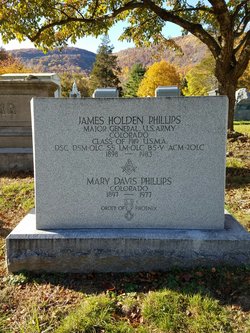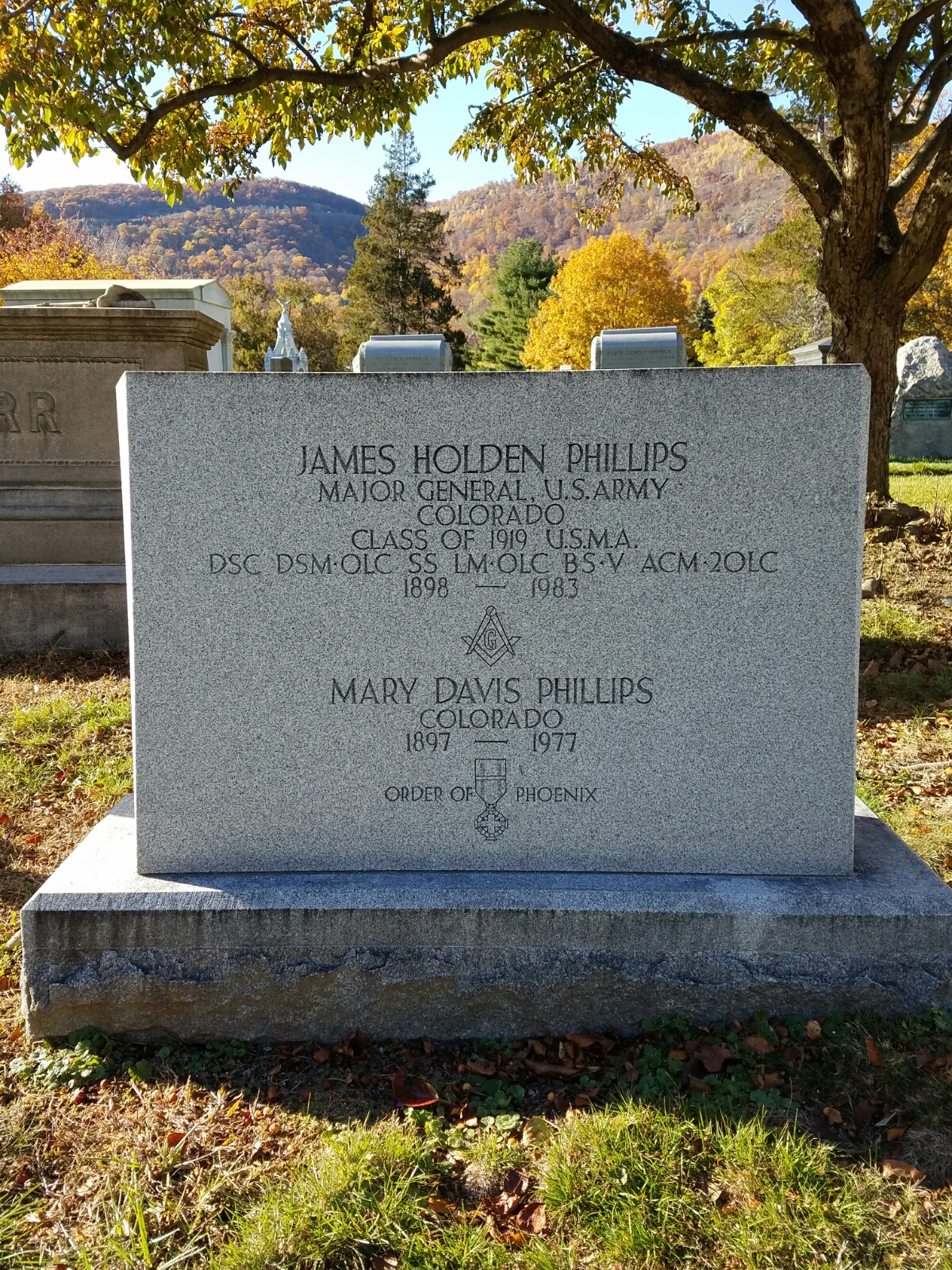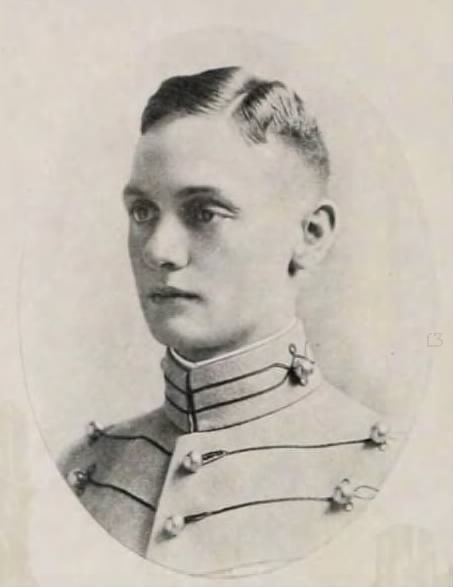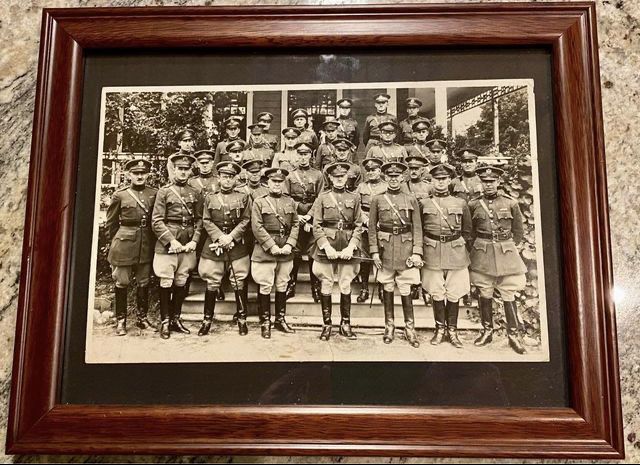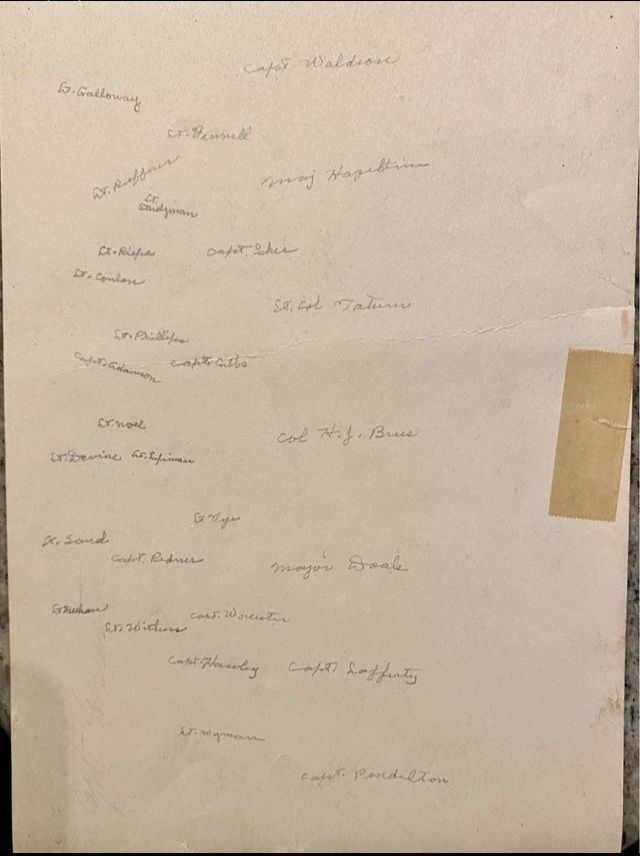USMA Class of 1919. Cullum No. 6355.
He was the son of Frank Phillips and Mabel Holden Phillips.
On September 15, 1923 as James Holden Phillips, he married Mary Ethel Davis at the home of her mother in Colorado Springs, Colorado.
They were the parents of two children.
On November 25, 1977 as James H. Phillips, he married Elva V. McFarlin (name per marriage record) in Carmel, California.
They had no children.
She was born February 11, 1895 and died September 11, 1983. She was the widow of Major General William E.R. Covell (1892-1975), USMA Class of 1915. Her first marriage was in 1915 to Dr. Abram L. Van Meter (1886-1955). Her marriage to General Covell was sometime between November 1956-September 1958.
James Holden Phillips was born on August 14, 1898, in Eastonville, Colorado. He attended elementary schools in Colorado and in June 1916 graduated from high school at Colorado Springs where he was president of the high school. In June 1917 he entered the United States Military Academy, graduating on November 1, 1918 with a commission as a second lieutenant in the Cavalry. After a tour of World War I, battlefields and returning to West Point, he entered the Cavalry School at Fort Riley in Kansas. He then joined the 9th Cavalry in the Philippine Islands. In 1922, he returned to the United States and was assigned to the 11th Cavalry at the Presidio of Monterey in California. He married his high school sweetheart, Mary Davis, to whom he was married for 53 years until her death in 1977. They were the parents of James H. Phillips Jr. and Charles Davis Phillips, both of whom graduated from West Point in 1951. In 1926, he was assigned to the 2nd Cavalry Regiment at Fort Riley. He applied for training in mechanization at the Quartermaster Corps Motor Transport School at Camp Holibird in Maryland from which he graduated in June 1931. He then joined the Mechanized Force, an experimental unit, at Fort Eustis in Virginia, becoming one of the early Cavalry pioneers in mechanization. Later that year he transferred to the 1st Cavalry Regiment (Mechanized) at Fort Knox in Kentucky. In August 1933 he entered the Command and General Staff School at Fort Leavenworth in Kansas. Upon completion of the two-year course, he became an instructor in mechanized and armor tactics at the Cavalry School at Fort Riley. In July 1940, he was named supply officer and commander of the provisional squadron of the 6th Cavalry Regiment (Horse and Mechanized) at Fort Oglethorpe in Georgia. He participated in polo, horsemanship and cross-country riding. He was also a rifle and pistol expert and was a member, coach and captain of the Cavalry Rifle and Pistol Team. He earned the Distinguished Rifle Marksmanship Badge and two legs on the Distinguished Pistol Marksmanship Badge. Under a plan devised by General Marshall, Chief of Staff, United States Army, to organize a section of the General Staff for the purpose of investigating new weapons, tactics, organizations and methods of combat, he was assigned to the Operations and Training Division of the War Department General Staff in May 1941. He was involved in the establishment and organization of the tank destroyers used in World War II. The horse and mechanized regiment were eliminated and the cavalry regiments became mechanized. He originated the plan to establish a desert training area in California. This later became known as the California-Arizona Maneuver Area, the largest maneuver area in the United States. In early 1942, he became the assistant to the assistant chief of staff for Training, Army Ground Forces. He helped organize and participated in all types of warfare: desert, mountain, airborne, amphibious and mechanized. He also authored the Army regulation for the identification of motor vehicles in a unit, which is still used as the basis for unit vehicle markings. In December 1943, as a colonel, he became chief of staff of III Corps with which he served at various stations in the United States until August 1944. The III Corps was assigned to the European Theater, where he continued to serve as its chief of staff. One of its first actions was the relief of Bastogne, followed by the advance across the Cologne Plain, the capture of Remagen Bridge, the establishment of the bridgehead over the Rhine River, the closure of the Ruhr pocket and the breakthrough to the Austrian border. III Corps had been ordered by First Army to secure the west side of the Rhine River until a bridgehead had been secured. Corps staff had been directed to prepare a plan to secure the bridge at Remagen and a bridgehead. At noon on March 7, 1945, III Corps received orders from First Army to move south to Koblenz to meet the Third Army. When word was received from the 9th Armored Division that the bridge had been seized and was still standing, all available combat troops were ordered to cross the bridge. He was awarded the Distinguished Service Cross by General Patton for his actions that day. At the end of the war he returned to the United States with the corps headquarters for service in the Pacific Theater. In March 1946 he became chief of staff of the 2nd Service Command at Governors Island in New York. He was then assigned to the War Department General Staff. In July 1946 he was appointed assistant chief, Public Information Division, becoming deputy chief in 1948. He directed the writing and publication of the first official History of the Medal of Honor, United States Army. In January 1949, he was sent to Greece as chief of staff of the Joint United States Military Advisory Group, remaining there for 2 1/2 years during the Greek Civil War. Next, he was appointed deputy assistant chief of staff for Intelligence, War Department General Staff. In 1953, he returned to Europe to become assistant chief of staff, G-2, United States Army Europe. After three years, he returned to the United States to become chief, United States Army Security Agency. It was his last position before his retirement for physical disability in September 1958. He was retired at Colorado Springs, the city from which he had entered military service. His awards included the Distinguished Service Cross, Distinguished Service Medal with Oak Leaf Cluster, Silver Star, Legion of Merit with Oak Leaf Cluster, Bronze Star with V [valor or bravery] and the Army Commendation Medal with Oak Leaf Cluster. Foreign decorations included the Legion of Honor Degree of Chevalier and Degree of Officer and Croix de Guerre with Palm from France; the Order of Leopold with Palm and Croix de Guerre with Palm from Belgium and other decorations from Luxembourg, Greece and Iran. After retirement, he and his wife moved to Carmel, California. He participated in the organization of the First Federal Savings and Loan Association of Monterey County and was Chair of the Board of that institution until 1981. After the death of his wife, Mary, he married Elva Covell, the widow of Major General W.E.R. Covell, USMA Class of 1915. They lived in Carmel until shortly before his death in 1983. Elva predeceased him by two months. Survivors included two sons, six grandchildren and one sister.
Source: United States Military Academy Association of Graduates memorial.
USMA Class of 1919. Cullum No. 6355.
He was the son of Frank Phillips and Mabel Holden Phillips.
On September 15, 1923 as James Holden Phillips, he married Mary Ethel Davis at the home of her mother in Colorado Springs, Colorado.
They were the parents of two children.
On November 25, 1977 as James H. Phillips, he married Elva V. McFarlin (name per marriage record) in Carmel, California.
They had no children.
She was born February 11, 1895 and died September 11, 1983. She was the widow of Major General William E.R. Covell (1892-1975), USMA Class of 1915. Her first marriage was in 1915 to Dr. Abram L. Van Meter (1886-1955). Her marriage to General Covell was sometime between November 1956-September 1958.
James Holden Phillips was born on August 14, 1898, in Eastonville, Colorado. He attended elementary schools in Colorado and in June 1916 graduated from high school at Colorado Springs where he was president of the high school. In June 1917 he entered the United States Military Academy, graduating on November 1, 1918 with a commission as a second lieutenant in the Cavalry. After a tour of World War I, battlefields and returning to West Point, he entered the Cavalry School at Fort Riley in Kansas. He then joined the 9th Cavalry in the Philippine Islands. In 1922, he returned to the United States and was assigned to the 11th Cavalry at the Presidio of Monterey in California. He married his high school sweetheart, Mary Davis, to whom he was married for 53 years until her death in 1977. They were the parents of James H. Phillips Jr. and Charles Davis Phillips, both of whom graduated from West Point in 1951. In 1926, he was assigned to the 2nd Cavalry Regiment at Fort Riley. He applied for training in mechanization at the Quartermaster Corps Motor Transport School at Camp Holibird in Maryland from which he graduated in June 1931. He then joined the Mechanized Force, an experimental unit, at Fort Eustis in Virginia, becoming one of the early Cavalry pioneers in mechanization. Later that year he transferred to the 1st Cavalry Regiment (Mechanized) at Fort Knox in Kentucky. In August 1933 he entered the Command and General Staff School at Fort Leavenworth in Kansas. Upon completion of the two-year course, he became an instructor in mechanized and armor tactics at the Cavalry School at Fort Riley. In July 1940, he was named supply officer and commander of the provisional squadron of the 6th Cavalry Regiment (Horse and Mechanized) at Fort Oglethorpe in Georgia. He participated in polo, horsemanship and cross-country riding. He was also a rifle and pistol expert and was a member, coach and captain of the Cavalry Rifle and Pistol Team. He earned the Distinguished Rifle Marksmanship Badge and two legs on the Distinguished Pistol Marksmanship Badge. Under a plan devised by General Marshall, Chief of Staff, United States Army, to organize a section of the General Staff for the purpose of investigating new weapons, tactics, organizations and methods of combat, he was assigned to the Operations and Training Division of the War Department General Staff in May 1941. He was involved in the establishment and organization of the tank destroyers used in World War II. The horse and mechanized regiment were eliminated and the cavalry regiments became mechanized. He originated the plan to establish a desert training area in California. This later became known as the California-Arizona Maneuver Area, the largest maneuver area in the United States. In early 1942, he became the assistant to the assistant chief of staff for Training, Army Ground Forces. He helped organize and participated in all types of warfare: desert, mountain, airborne, amphibious and mechanized. He also authored the Army regulation for the identification of motor vehicles in a unit, which is still used as the basis for unit vehicle markings. In December 1943, as a colonel, he became chief of staff of III Corps with which he served at various stations in the United States until August 1944. The III Corps was assigned to the European Theater, where he continued to serve as its chief of staff. One of its first actions was the relief of Bastogne, followed by the advance across the Cologne Plain, the capture of Remagen Bridge, the establishment of the bridgehead over the Rhine River, the closure of the Ruhr pocket and the breakthrough to the Austrian border. III Corps had been ordered by First Army to secure the west side of the Rhine River until a bridgehead had been secured. Corps staff had been directed to prepare a plan to secure the bridge at Remagen and a bridgehead. At noon on March 7, 1945, III Corps received orders from First Army to move south to Koblenz to meet the Third Army. When word was received from the 9th Armored Division that the bridge had been seized and was still standing, all available combat troops were ordered to cross the bridge. He was awarded the Distinguished Service Cross by General Patton for his actions that day. At the end of the war he returned to the United States with the corps headquarters for service in the Pacific Theater. In March 1946 he became chief of staff of the 2nd Service Command at Governors Island in New York. He was then assigned to the War Department General Staff. In July 1946 he was appointed assistant chief, Public Information Division, becoming deputy chief in 1948. He directed the writing and publication of the first official History of the Medal of Honor, United States Army. In January 1949, he was sent to Greece as chief of staff of the Joint United States Military Advisory Group, remaining there for 2 1/2 years during the Greek Civil War. Next, he was appointed deputy assistant chief of staff for Intelligence, War Department General Staff. In 1953, he returned to Europe to become assistant chief of staff, G-2, United States Army Europe. After three years, he returned to the United States to become chief, United States Army Security Agency. It was his last position before his retirement for physical disability in September 1958. He was retired at Colorado Springs, the city from which he had entered military service. His awards included the Distinguished Service Cross, Distinguished Service Medal with Oak Leaf Cluster, Silver Star, Legion of Merit with Oak Leaf Cluster, Bronze Star with V [valor or bravery] and the Army Commendation Medal with Oak Leaf Cluster. Foreign decorations included the Legion of Honor Degree of Chevalier and Degree of Officer and Croix de Guerre with Palm from France; the Order of Leopold with Palm and Croix de Guerre with Palm from Belgium and other decorations from Luxembourg, Greece and Iran. After retirement, he and his wife moved to Carmel, California. He participated in the organization of the First Federal Savings and Loan Association of Monterey County and was Chair of the Board of that institution until 1981. After the death of his wife, Mary, he married Elva Covell, the widow of Major General W.E.R. Covell, USMA Class of 1915. They lived in Carmel until shortly before his death in 1983. Elva predeceased him by two months. Survivors included two sons, six grandchildren and one sister.
Source: United States Military Academy Association of Graduates memorial.
Family Members
Sponsored by Ancestry
Advertisement
Advertisement
